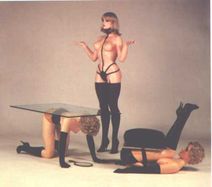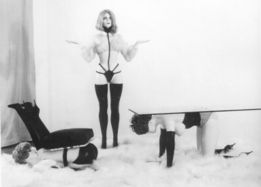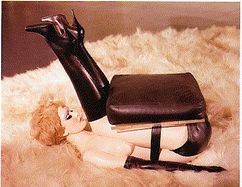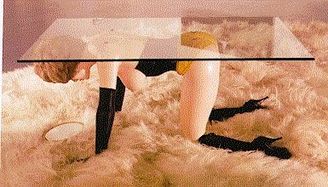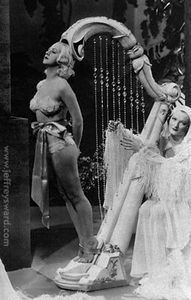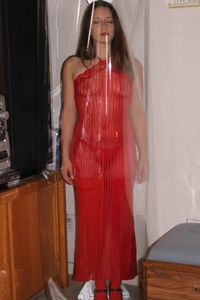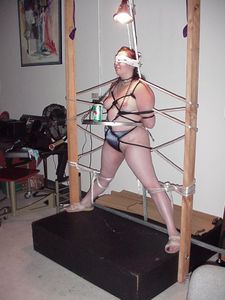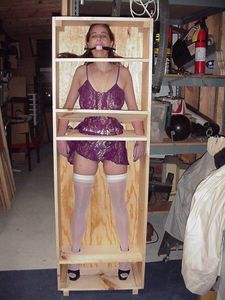Forniphilia
- This article is part of the SM-201 Micropedia
There is a form of sexual bondage that involves making furniture designed to incorporate a bound person. It is sometimes known as forniphilia.
The best-known example of forniphilia in art is by British artist Allen Jones who has a very famous series of sculptures called "Hat Stand and Table", made in 1969, which show semi-naked women in the roles of furniture. It's a very striking and provocative work bound to create strong reactions. According to viewer, those works can been seen in a very ambivalent way: either, as a fantasy of sexual objectification, or, a critical and ironic comment on that objectification and woman's role in society -- even though this interpretation is very problematic, as we can see.
Feminists have criticized Jones' painted and sculptured women images. In 1973 Laura Mulvey discussed in the feminist magazine Spare Rib Jones' images in relation to fetishism in the Freudian sense. Mulvey argued that Jones repeated typical fetishistic female imagery familiar from media and pop culture. She suggested that his work is not about women at all, but illustrates Jones' male fears. These images are related to fetishism in the strictly Freudian sense, and reproduce the woman as spectacle, as primarily sexual being, and as the object of a specifically masculine gaze/desire. The notion of the woman bound and restricted through shoes and clothing is addressed in Mulvey's critique of the art of Allen Jones. Mulvey writes, "The most effective fetish both constricts, and up-lifts, binds and raises, particularly high-heeled shoes, corsets and bras" (Mulvey, Laura: "You Don't Know What's Happening, Do You Mr. Jones?" in Framing Feminism, p. 128). High-heels represent heightened sexuality, yet a lack of agency in their inhibition of movement. Shackles of a sort, they place the female wearer in a position of greater vulnerability than that of the male.
Forniphilia is a phrase coined by Jeff Gord at the House of Gord to the love of creating furniture from humans. Forniphilia is a sub-set of bondage and sexual objectification in which a person's body is incorporated into inanimate tool or piece of furniture. Allen Jones' sculptures Hat Stand and Table Sculpture, made in 1969, which show semi-naked women in the roles of furniture, is a classic example of the depiction of forniphilia as art.
The House of Gord website often uses a more extreme form of forniphilia in its bondage. Forniphilia is an extreme form of bondage because the subject is tightly bound and expected to stay immobile for long or indefinite period of time.
The term is derived from;
- forni- f. Old French furnir f. Roman, fornire; to furnish, furniture
- -philia f. Greek philos; love of, fondness for
Forniphilia in Film
- The Korova Milkbar is one of the bars where Alec and his "Droogies" hang out between attacks on the general populace.
- The 1963 film Soylent Green is set in an overpopulated futuristic Earth, which tells a story of a New York cop named Thorn (Charlton Heston), who is investigating a death of a upper class citizen Simmons. Thorn finds himself marked for murder by government agents when he gets too close to a bizarre state secret involving the origins of a revolutionary and needed new foodstuff. On his way Thorn, and actually the whole world of this film, displays by his behaviour, that the world has changed into a exact opposite of utopia.
- During some questioning of Simmons's "furniture" Shirl played by Leigh Taylor-Young, the movie goes so far as to refer to women as "furniture", available on a personalized basis to those well-to-do citizenry that could afford "the very best". Anyone for "hot and cold running maids".
- La Femme Objet is the story of a science fiction writer who is completely addicted to sex. He needs it from morning to night and cannot be in the presence of a woman without making love to her, whether she is asleep, in the process of washing the dishes, or anything else. The story begins with his girlfriends Sabine (Helene Shirley) leaving him, telling him as she parts that she wants to live and his demands are literally killing her. The next girlfriends suffers the same fate, as does the secretary he hires and a woman who is designing sets for the movie adaptation of his latest book. Realizing that no living woman can satisfy him, he sets up a laboratory in the basement and builds a true to life, remote controlled robot woman- his "female object" (Marilyn Jess). At first life is good, as the stunning, busty blonde robot can not speak- and wouldn't complain if she could- and satisfies his every sexual whim. He ironically observes, "She is more feminine than any woman I have ever known".
- However, as time goes on, something goes wrong with the experiment. The robot begins to develop a personality of its own, and refuses to obey his commands. Soon she is out of control, screwing the mailman, his ex Sabine, and anyone else who comes by the house. The writer does not have the heart to destroy her, but he decides to make another robot to replace her nonetheless- this time a gorgeous ebony creature. But, once again, our man has miscalculated. It is not long before his blonde robot has seduced his ebony creation, and soon neither is obeying his commands. In fact, he is now outnumbered in his own home, and as the film ends he finds that it is now he who is obeying their commands and satisfying their desires. He has became "le homme objet"- the male object.
- Art by Allen Jones
- from Busby Berkeley film
- Photos by Robin Roberts
See also Forniphilia Feelings A story by Master Robin and Annie
See also Forniphilia gag , Allen Jones and/or House of Gord
External Links
| Other A.S.F.R. / Robot related topics | |
|---|---|
What links here • References and Sources • Contact Info
